Old laptop batteries still have enough life in them to power homes in slums, researchers have said. An IBM study analyzed a sample of discarded batteries and found 70% had enough power to keep an LED light on more than four hours a day for a year. Researchers said using discarded batteries is cheaper than existing power options, and also helps deal with the mounting e-waste problem.
The IBM team created what they called an UrJar, a device that uses lithium-ion cells from the old batteries to power low-energy DC devices, such as a light. The researchers are aiming to help the approximately 400 million people in India who are off grid. Options such as solar power are considerably more expensive and logistically more cumbersome at the moment. If the UrJar, which would last a year, is made in sufficiently large volume, researchers estimate the price per unit at just 600 rupees (about £7). They conclude: “UrJar has the potential to channel e-waste towards the alleviation of energy poverty, thus simultaneously providing a sustainable solution for both problems.”
IBM’s research said 142,000 computers are thrown away in the US daily, around 50 million a year. India’s predicament is particularly urgent. Not only does the country receive a lot of e-waste from other countries, but with a booming IT market it is also generating huge amounts of its own around 32 tonnes a day, according to one estimate. Computer Aid, a UK-based charity that redistributes unwanted old technology, welcomed the initiative. “We think that this is an excellent initiative as it is in line with our practice of reusing and refurbishing rather than recycling,” said Keith Sonnet, its chief executive. “Refurbishing has definitely a more positive impact on the environment and we should encourage more companies to adopt this practice.”
The researchers tested prototypes with five users in an Indian slum, four of whom used the devices at the small roadside stands where they work. The users said that they would be willing to pay 1000 rupees (16 USD) for the product. But Tech Review reports that IBM is not planning on turning the technology into a business, and instead may make the UrJar’s blueprints available at no cost to developing countries.

